Nigeria’s 6-year (2018–2023) stage distribution of breast cancer at diagnosis: a systematic review and meta-analysis
Agodirin Olayide1, Chijioke Chijindu2, Mustapha Fathi3, Rahman Ganiyu4, Olatoke Samuel1, Olaogun Julius5 and Akande Halima6
1Department of Surgery, University of Ilorin and University of Ilorin Teaching Hospital, Ilorin 240003, Kwara State, Nigeria
2Department of Surgery, University of Ilorin Teaching Hospital, Ilorin 240003, Kwara State, Nigeria
3Crescent Gold Crown Multispecialist Hospital, Ilorin 240222, Nigeria
4Department of Surgery, University of Cape Coast and Cape Coast Teaching Hospital, Cape Coast 000233, Ghana
5Department of Surgery, Ekiti State University and Ekiti State University Teaching Hospital, Ado Ekiti 360101, Ekiti State, Nigeria
6Department of Radiology, University of Ilorin and University of Ilorin Teaching Hospital, Ilorin 240003, Kwara State, Nigeria
Abstract
Background: Nigeria has implemented various interventions to reduce late-stage breast cancer (BC) diagnosis in recent decades. This meta-analysis assessed the impact of these efforts by examining recent BC stage distribution data.
Methods: A systematic review adhering to Preferred Reporting Items for Systematic Reviews and Meta-analysis guidelines was conducted. PubMed was searched for studies on BC in Nigeria from 2018 to 2023 and additional articles were identified through hand searching and snowballing in African Journal Online, Google Scholar and ResearchGate. Data on patient demographics, time to diagnosis at tertiary center and stage distribution were extracted and meta-analyzed using a random-effects model. A simple comparison with historical data of 2000–2018 was conducted.
Results: Eleven articles reported the stage distribution of 1,647 BC patients. Overall analysis of the recent stage distribution showed a slight decrease in stages I, II and IV and an increase in stage III. However, these changes were accompanied by wider confidence intervals: 6% 95% confidence intervals (95% CI 0–15), 17% (6%–29%), 56 (95% CI 38–68) and 21 (9–34) were stages I–IV, respectively, compared to 8% (95% CI 3–13), 21% (14%–28%), 44 (95% CI 33–51) and 29 (21–37) in the historical data. The sensitivity analysis, using a two-stage classification as (‘early’ or ‘late’ disease), strongly indicated a trend towards more advanced-stage (82% CI 79–85) disease in the recent analysis.
Conclusion: Advanced-stage BC remains prevalent in Nigeria. A comprehensive evaluation of current BC control strategies is needed to identify barriers and develop effective interventions for early diagnosis and treatment.
Keyword: breast cancer, stage, Nigeria
Correspondence to: Agodirin Olayide
Email: cancer1992@yahoo.com
Published: 25/04/2025
Received: 17/10/2024
Publication costs for this article were supported by ecancer (UK Charity number 1176307).
Copyright: © the authors; licensee ecancermedicalscience. This is an Open Access article distributed under the terms of the Creative Commons Attribution License (http://creativecommons.org/licenses/by/4.0), which permits unrestricted use, distribution, and reproduction in any medium, provided the original work is properly cited.
Introduction/background
Breast cancer (BC) is a significant public health concern. According to the 2024 GLOBOCAN report, the global estimated number of new cases of BC is about 2.3 million, which accounts for 11.6% of cancers in 2022 [1].
WHO data shows significant inequities in the cancer burden, with the effect being more profound in developing countries. Women in high human development index (HDI) countries have a 1 in 12 lifetime risk of BC diagnosis and a BC death rate of 1 in 71 women. In contrast, women in lower HDI countries have a lower lifetime risk of BC diagnosis of 1 in 27 women, yet with a higher expected death rate of 1 in 48 from BC [2].
Nigeria bears a significant burden of BC and has one of the highest age-standardised mortality globally [3]. Over the past years, there has been a substantial increase in the incidence of BC in Nigeria, with the most current available estimate of 54.3 per 100,000 in a 2012 report [4].
A recent meta-analysis involving 23 African countries, encompassing data between 2000 and 2018, shed light on the stage of BC diagnosis across the continent [5], and Nigeria contributed nearly 29% of the included studies. The analysis revealed that advanced-stage tumours were most prevalent in West Africa, with more than 70% advanced-stage disease and Nigeria had the highest proportion of advanced cases, with 91% clinical lymph node positivity [5].
The Nigerian Institute for Cancer Research and Treatment (NICRAT) [6] was established to spearhead cancer control efforts in Nigeria. Their 2018–2022 National Cancer Control Plan aimed to improve access to cancer screening, early detection and timely diagnosis to enhance treatment outcomes. Prior to ‘NICRAT’s establishment and intensifying since then, healthcare providers in the Nigerian healthcare system have implemented various interventions to improve BC awareness, screening programs and access to healthcare services. These initiatives include targeted education campaigns, efforts to improve screening facilities, increased diagnostic tool availability and enhanced healthcare infrastructure [7–12]. These efforts aimed to facilitate early detection and ultimately downstage BC at diagnosis.
Unfortunately, the NICRAT’s executive document outlining the National Strategic Plan for 2023–2027 reported underperformance of the 2018–2022 cancer control plans. In light of these findings, this study aimed to revisit and update the previous meta-analysis by incorporating Nigeria’s most recent and available BC stage distribution data. By doing so, we seek to evaluate the impact of implemented interventions on the stage of BC diagnosis within the country. The current analysis will extend the data for Nigeria from the previous meta-analysis, and a shift towards earlier stages at diagnosis might serve as indirect evidence of the effectiveness of implemented interventions in downstaging BC in Nigeria.
Methods
This review adhered to the Preferred Reporting Items for Systematic Reviews and Meta-analysis recommendations. After the scoping search, no similar ongoing research was found, so the review was registered on the International Prospective Register for Systematic Reviews (PROSPERO) with ID CRD42023454267.
Literature search
We conducted full electronic searches in PubMed.gov and supplemented this with hand searching and snowballing techniques. Hand searching involved page-by-page search until page end or saturation in Google, Google Scholar, African Journal Online (AJOL) and ResearchGate to identify additional relevant articles. Snowballing involved reviewing reference lists of articles retrieved after the full electronic and hand search. The search terms ‘BC AND Nigeria’ were applied across all databases and search engines. An initial search opened on 15 August 2023 and closed on 22 August 2023. A supplementary search was conducted between December 21 and 30 December 2023. Where necessary, authors of the included articles were contacted for clarification of missing or obscured data, and the authors’ response window was closed on 5 March 2024, before the final analysis.
Eligibility criteria
Studies were included based on predetermined PICOTS criteria (detailed in the supplementary PICOTS table). Briefly, eligible studies satisfied the following.
- Population: Reported on female patients with BC in Nigeria.
- Intervention: Not applicable.
- Control: Not applicable.
- Outcomes: Reported the stage of BC at presentation and/or time of arrival at a specialist clinic (primary outcomes).
- Time: Published between 1 January 2018 and 31 December 2023 (articles published in this period but including data before January 1, 2011, were excluded).
- Study design: Original articles with extractable data and a sample size of at least ten participants. There were no language restrictions.
Study selection
Two independent reviewers (CC and MF) screened the articles using a two-stage process. First, titles and abstracts were screened based on eligibility criteria. Second, full-text articles of potentially relevant studies were retrieved and assessed for final inclusion. Disagreements at any stage were resolved through discussion with a third reviewer (AO).
Quality of included studies
The quality of the included studies was assessed using a modified version of the Critical Appraisal Skills Programme (CASP) tool [13] (supplementary file) to evaluate five key domains:
- Validity/Relevance/Applicability: Assessed based on the study’s aim and alignment with the review question.
- Results presentation and reliability: Assessed based on clarity and consistency of reported findings.
- Bias: Assessed based on the representativeness of the study population compared to the target population.
- Precision of staging: Assessed based on the methods used for staging and potential for recall bias.
- Reporting: Assessed based on the ease of extracting relevant data.
Statistical analysis
The analysis of the stage at presentation was conducted in two instances. First, a granular analysis focused on individual stages (I–IV). Second, a combined analysis explored the early (I and II) and late (III and IV) stages. To facilitate data aggregation across studies, the proportion of patients in each stage category was calculated by dividing the number of patients in each stage by the sum of patients in all the stages. These proportions were then transformed into summary effect sizes using a random-effects model in the MetaXL add-in for Microsoft Excel (accessible at <a href=https://www.epigear.com><a href=https://www.epigear.com>www.epigear.com</a></a>). The double arcsine transformation was employed to address potential skewness in proportions. Heterogeneity was assessed using the I² statistic, with 75% or higher indicative of substantial heterogeneity.
A similar meta-analytical approach was applied to patient demographics (age, educational status and marital status) and time to a presentation at a specialist clinic, categorised (based on available data) as less than 0–6, 7–12 and >12 months. Age was categorised as <21, 21–30, 31–40, 41–50, 51–60 and >60 years. Educational status was categorised as none, primary, secondary and tertiary, while marital status was categorised as single, married and others (others representing divorced, separated or widowed). Results are presented as percentages with 95% confidence intervals (95% CI). Forest plots for all analyses are included in the supplementary file. Data from articles that did not allow for aggregation were presented narratively.
Result
Article selection
The literature search strategy yielded eight articles that met the eligibility criteria. The initial electronic search on PubMed.gov identified 387 articles, of which only three were relevant (14–16). Eight (17–24) additional relevant articles (16–23) were found through supplementary hand and snowballing techniques in Google, Google Scholar, AJOL and ResearchGate. Figure 1 (supplementary file) illustrates the article selection process and Table 1 (supplementary file) summarises the characteristics of the included studies.
Patient demographics
Six articles [17–19, 21, 22, 24] encompassing data from 751 patients were included in the analysis of age distribution. Three articles (410 subjects) [20, 22, 24], contributed data on educational status and four articles (362 subjects) [19, 20, 23, 24] provided data on marital status.
The modal age group was 41–50 years, representing 31% (95% CI 23–40) of subjects (I² = 83%). Nearly half of the subjects had a tertiary education level (47%, 95% CI 21–72, I² = 95%) and the vast majority were married (87%, 95% CI 71%–95%, I² = 89%). Demographic distributions are shown in Table 2.
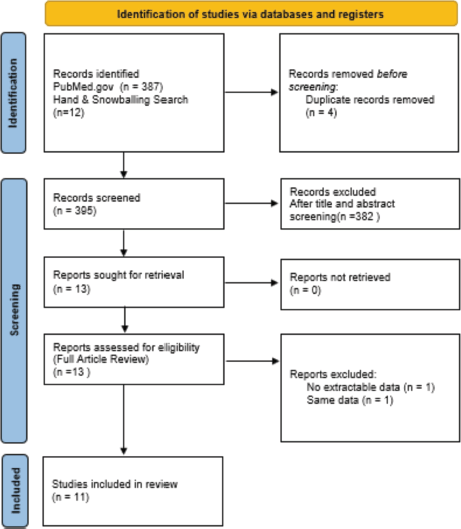
Figure 1. Article selection. Figure 1 shows the article selection process. A total of 399 articles were screened and only 11 were eligible.
Table 1. Article characteristics.
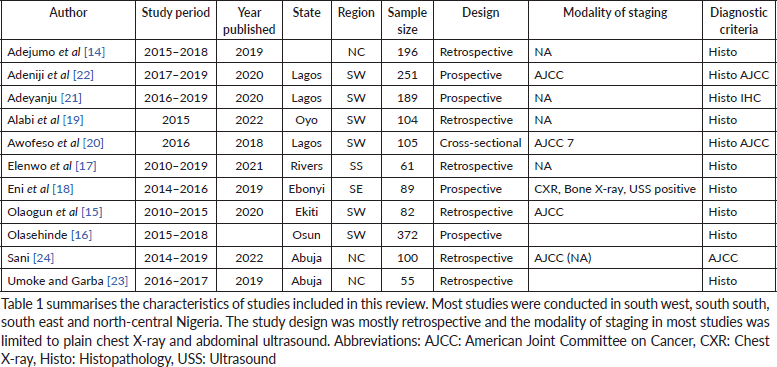
Table 2. Summary estimates of subjects’ demographics.
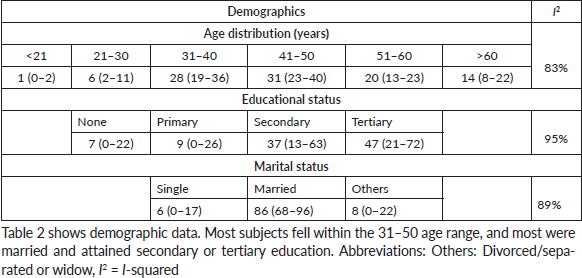
Duration of illness before presentation
Four articles (501 subjects) [17, 18, 22, 24] contributed data to the duration of illness analysis. An estimated 42% (95% CI 22–61, I² = 94%) of patients presented within 6 months of detecting the breast change, 37% (95% CI 39–51, I² = 94%) presented between 7 and 12 months and 21% (95% CI 15–32, I² = 83%) presented after 12 months. A single study by Sani [24] provided more granular data for a subset of 100 patients, showing that 3.0% presented within one month and 11% presented between 2 and 3 months.
Stage of BC at presentation in study (tertiary) centre
Nine studies (1,482 subjects) [14–22] (contributed to the granular IV stage analysis, while all studies (1,647 subjects) contributed to the two-stage analysis. In the granular individual stages, the most frequent stages at presentation were Stage III (56%, 95% CI 38–68) and Stage IV (21%, 95% CI 9–34), with a high heterogeneity (I² = 96%) across studies (Table 3, Figure 2). In the combined Stages, when stages were grouped as early (Stage I and II) and advanced (Stage III and IV), 76% (95% CI 67–84) of patients presented with advanced disease (Table 3, Figure 3).
Table 3. Summary estimates of stage at presentation.
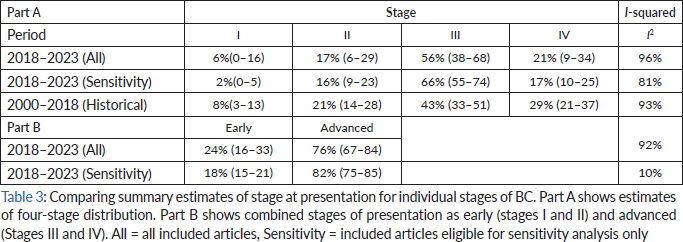
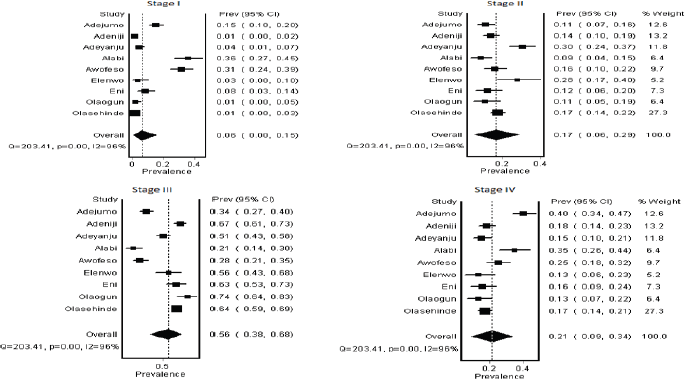
Figure 2. Summary estimate of individual stage of BC recorded at Nigerian study centers (2018–2023 publications).
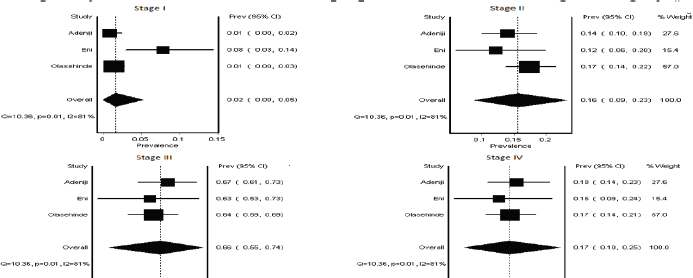
Figure 3. Summary estimate combined stages of BC recorded at Nigerian study centers (2018–2023 publications).
Sensitivity analysis
To strengthen the reliability of our stage distribution estimates, we conducted a sensitivity analysis focusing on studies with prospective designs and detailed data collection methods description. This analysis included three eligible articles (713 subjects) [16, 18, 22].
The results of the sensitivity analysis largely mirrored the overall findings. However, while heterogeneity persisted in the four-category analysis, it was significantly reduced in the two-category analysis. Further examination of the four-category analysis revealed that heterogeneity primarily stemmed from variations in early-stage disease diagnosis. One study reported a notably higher rate of Stage I disease (8%) compared to the other two (1%) (Figures 4 and 5).
Discussion
This review aimed to describe the summary estimates of the current stage of BC diagnosis in Nigeria, and by comparing current data from 2018 to 2023 with past analyses from 2000 to 2018, we also indirectly evaluated the impact of the current National Strategic Cancer Control Plan (2023–2027) downstaging program.
Despite the similar patient demographics as previously [5], this study’s findings revealed a concerning trend. Aggregate data in the last 6 years showed that the majority of patients were diagnosed after 6 months of symptom detection, and less than 15% presented within 3 months in a more granular single study analysis [24]. In the overall analysis of stage distribution, more than two-thirds (76%, 95%CI 67–84) were diagnosed with advanced stages (III and IV), and only 6% and 17% were diagnosed in stages I and II, respectively, suggesting persistence of challenges in downstaging BC in Nigeria.
To understand how the stage of BC in Nigeria has changed over time, we reviewed available PubMed studies. Data before 2000 was scarce. However, early single studies by Pearson [25] and Chiedozi [26] reported alarmingly high rates of advanced BC, with 95% and 85% of patients, respectively, diagnosed at stages III or IV. More recent aggregate data from 2011 to 2018 showed similar concerning rates (79%) [5]. Our current analysis confirms this trend, with 76% of cases classified as late or advanced in the overall analysis and 82% as advanced or metastatic in the sensitivity analysis. This suggests little improvement in BC stage at diagnosis since the 1980s, aligning with concerns raised by NICRAT about the lack of effectiveness of previous cancer control strategies. Comparing Nigeria to other regions, our estimated metastatic BC rate of 21% falls within the broader range of 5.6% to 30.6% reported for Sub-Saharan Africa (2022) [5, 27].
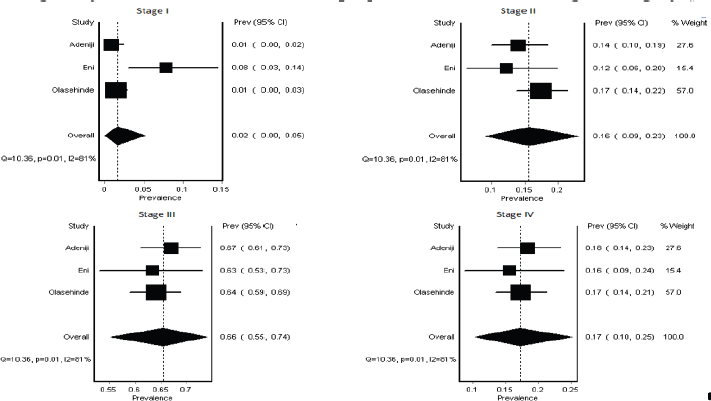
Figure 4. Sensitivity analysis. Figure showing forest plot of the sensitivity analysis of the four-category analysis, shows predominance of late-stage presentation and persistence of high heterogeneity with marked differences in proportions noted in the stage I category.
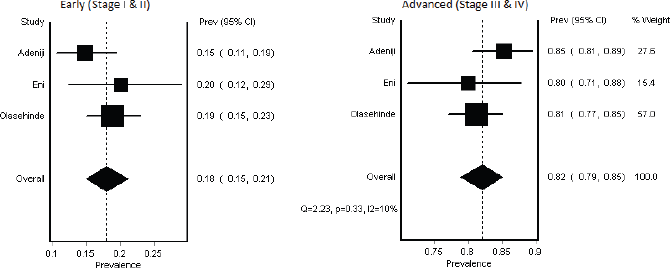
Figure 5. Sensitivity analysis. Figure showing forest plot of the sensitivity analysis of the combined two category staging analysis shows a predominance of late-stage presentation and no heterogeneity.
Our analysis also showed substantial heterogeneity in the data as indicated by high I2 values, consistent with previous analyses from Africa and Nigeria [5, 28, 29]. In the context of the current study, the high heterogeneity suggests significant variations and probably inaccuracies in diagnostic and staging practices across facilities. This emphasises the need for standardised data collection and reporting practices including developing and implementing a standardised system, training healthcare professionals, and establishing a central cancer registry as part of the NICRAT plan.
Given the reliance on basic imaging modalities such as ultrasound and chest X-ray as the primary staging tools in Nigeria, it is important to optimise the use of these diagnostic tools through the development of context-specific guidelines, training of clinicians and implementing of quality assurance programs to ensure accuracy and reliability of results.
The summary estimate of the BC stage distribution was analyzed using two classification systems: the granular four-stage classification system and the simplified two-stage classification. The summary estimates were more consistent in simplified two-stage classification (early versus late/advanced) than the detailed four-stage system (I–IV). This consistency is likely due to the broader categorisation of the two-stage system, which avoids the complexities and potential subjectivity associated with distinguishing finer gradations within Stages I–IV. Although simplification improves comparability, it sacrifices the detailed and functional information provided by the comprehensive staging system.
The comprehensive 8th Edition of the tumor node metastasis (TNM) staging system, which incorporates biomarkers, offers a detailed cancer profile [30] and aids in treatment selection. However, simplified systems can enhance consistency in diverse settings. Balancing consistency and detail is essential and the optimal approach depends on the context. Simplified systems are valuable for population-level monitoring, whereas the comprehensive TNM system is crucial for individualised treatment planning and prognosis [31], particularly in the early stages. Addressing staging inconsistencies requires the adoption of a standardised staging system, such as a simplified two-stage system for population-level monitoring and the TNM system for individualised treatment as part of the NICRAT plan. Regardless of the system used, diagnostic, staging and reporting criteria should be consistent across the Nigeria.
Inconsistent data collection and reporting practices, as evidenced by wide confidence intervals in this and other studies, hinder effective BC policymaking in Nigeria and Africa. Standardising data collection and reporting will help to address this challenge.
While access to advanced imaging like computed tomography (CT) scans and magnetic resonance imaging (MRI) is limited in resource-constrained settings, healthcare facilities can enhance BC staging by optimally utilising available tools. This includes high-frequency ultrasound, doppler imaging, digital radiography and blood tests, such as liver function tests, serum calcium and phosphate and tumour markers.
Artificial intelligence (AI) offers a promising avenue for improving staging in resource-limited environments [32]. While AI cannot fully replace advanced imaging, it can complement basic diagnostic modalities by providing valuable insights based on available information [32].
With the current trend of advanced computing, machine learning (ML) algorithms and AI can analyze patient data (such as clinical records, laboratory results and basic imaging) and directly map clinical data to stage [32, 33] or indirectly predict cancer stages by mapping clinical data to survival patterns [34]. ML/AI predictions can be preliminary proxies for selecting more expensive high-resolution staging modalities. In the absence of high-end diagnostic modalities, pre-trained deep learning models can be fine-tuned on limited data by using transfer learning [35]. Continuing efforts to expand access to comprehensive diagnostic services will remain essential alongside AI integration.
The new National Strategic Cancer Control Plan (2023–2027) in Nigeria aims to improve BC care by addressing key challenges, including late presentation and stage at diagnosis of BC, limited access to diagnostic tools and inconsistent data collection. For the new NICRAT plan to achieve its aims, a robust monitoring and evaluation framework will be essential to assess progress and make necessary adjustments. Strengthening healthcare infrastructure by improving access to diagnostic equipment, increasing the number of trained personnel and enhancing overall healthcare quality will be crucial for successful implementation.
Limitations of the study and future directions
High heterogeneity, low-resolution staging modalities and narrow spread of reports are limitations of this review findings. Nonetheless, the findings highlight an urgent need for a comprehensive evaluation to identify key factors hindering progress in downstaging BC in Nigeria. This evaluation should guide the development of new, evidence-based approaches for earlier detection, diagnosis and treatment.
Specifically, research should focus on strategies to increase screening participation and shorten the time between detection, diagnosis and treatment. Strengthening healthcare infrastructure is also essential. This will involve providing necessary diagnostic equipment, well-trained staff and standardised procedures for diagnosis and staging. All strategies should incorporate continuous monitoring and evaluation to ensure ongoing improvements.
Conclusion
Our analysis of BC data from 2018 to 2023 revealed a persistent pattern of late presentation in tertiary centers and advanced-stage diagnosis in Nigeria. This trend mirrors findings from previous studies spanning two decades. Regarding BC downstaging, the results align with the NICRAT report of 2023, indicating the ineffectiveness of previous strategies to reduce advanced BC cases in Nigeria.
Acknowledgment
We acknowledge the prior effort of authors and journal houses that published the articles included in this review. The included articles have been duly referenced.
Conflicts of interest (COI) disclosure
- Agodirin Olayide: No conflicts of interest to declare.
- Chijioke Chijindu: No conflicts of interest to declare.
- Mustapha Fathi: No conflicts of interest to declare.
- Rahman Ganiyu: No conflicts of interest to declare.
- Olatoke Samuel: No conflicts of interest to declare.
- Olaogun Julius: No conflicts of interest to declare.
- Akande Halima: No conflicts of interest to declare.
Funding/Financial support statement
This research did not receive any specific grant from funding agencies in the public, commercial or not-for-profit sectors.
Consent for publication
No patient consent was required for this manuscript.
Ethics approval and consent to participate
No patient consenting required for this manuscript and no approval from any institutional ethics committee required. All included studies are freely available published articles that have satisfied prior ethical considerations and have been duly referenced.
Availability of data and material
All data used in the analysis are freely available in the studies included. Results of the meta-analysis have been presented in the manuscript or supplementary file.
Author contributions
All authors contributed to conceiving and developing proposal for this project. AO conducted the article search and registration of proposal, CC, MF and AO contributed to the article selection process. CC and MF extracted data for analysis and AO conducted the statistical analysis. All authors contributed equally to the development and review of the final manuscript.
References
1. Bray F, Laversanne M, and Sung H, et al (2024) Global cancer statistics 2022: GLOBOCAN estimates of incidence and mortality worldwide for 36 cancers in 185 countries CA Cancer J Clin 2024 74(3) 229–263 https://doi.org/10.3322/caac.21834 PMID: 38572751
2. World Health Organization (2021) Breast cancer [Internet] [https://www.who.int/news-room/fact-sheets/detail/breast-cancer] Date accessed: 4/10/2024
3. Azubuike SO, Muirhead C, and Hayes L, et al (2018) Rising global burden of breast cancer: the case of sub-Saharan Africa (with emphasis on Nigeria) and implications for regional development: a review World J Surg Oncol 16(1) 63 https://doi.org/10.1186/s12957-018-1345-2 PMID: 29566711 PMCID: 5863808
4. Jedy-Agba E, Curado MP, and Ogunbiyi O, et al (2012) Cancer incidence in Nigeria: a report from population-based cancer registries Cancer Epidemiol 36(5) e271–278 https://doi.org/10.1016/j.canep.2012.04.007 PMID: 22621842 PMCID: 3438369
5. Agodirin O, Aremu I, and Rahman G, et al (2021) Demographic pattern, tumor size and stage of breast cancer in Africa: a meta-analysis Asian Pac J Cancer Care 6(4) 477–492 https://doi.org/10.31557/apjcc.2021.6.4.477-492
6. National Institute for Cancer Research and Treatment NICRAT [Internet] 2021 [https://nicrat.gov.ng] Date accessed: 4/10/2024
7. Okeke NE and Makata CC (2019) Breast cancer media campaigns among women: an explicatory review Int J Int Relat Media Mass Commun Stud 5(5) 62–77
8. Ogunkorode LH, Anonson J, and Maree J (2017) Promoting early detection of breast cancer and care strategies for Nigeria Afr J Reprod Health 21(2) 18–25 https://doi.org/10.29063/ajrh2017/v21i2.3
9. Salako O, Roberts AA, and Isibor VI, et al (2017) Innovative breast cancer awareness and advocacy campaign J Glob Oncol 3(2) 169–176 https://doi.org/10.1200/JGO.2016.003509 PMID: 28717755 PMCID: 5493274
10. Omisore AD, Olasehinde O, and Wuraola FO, et al (2023) Improving access to breast cancer screening and treatment in Nigeria: the triple mobile assessment and patient navigation model (NCT05321823): a study protocol PLoS One 18(6) e0284341 https://doi.org/10.1371/journal.pone.0284341 PMID: 37310983 PMCID: 10263304
11. Omisore AD, Sutton EJ, and Akinola RA, et al (2023) Population-level access to breast cancer early detection and diagnosis in Nigeria JCO Glob Oncol 9 e2300093 https://doi.org/10.1200/GO.23.00093 PMID: 38096465 PMCID: 10730078
12. Olasehinde O, Boutin-Foster C, and Alatise OI, et al (2017) Developing a breast cancer screening program in Nigeria: evaluating current practices, perceptions, and possible barriers J Glob Oncol 3(5) 490–496 https://doi.org/10.1200/JGO.2016.007641 PMID: 29094087 PMCID: 5646896
13. Critical Appraisal Skills Programme (CASP) (2021) CASP checklists [Internet] [https://casp-uk.net/casp-tools-checklists/] Date accessed: 4/10/2024
14. Adejumo AA, Ajamu OJ, and Akanbi OO, et al (2019) Epidemiology and challenges of managing breast cancer in Keffi, North-Central Nigeria: a preliminary report Niger Med J 60(4) 193–197 https://doi.org/10.4103/nmj.NMJ_45_19 PMID: 31831939 PMCID: 6892332
15. Olaogun JG, Omotayo JA, and Ige JT, et al (2020) Socio-demographic, pattern of presentation and management outcome of breast cancer in a semi-urban tertiary health institution Pan Afr Med J 36 363 https://doi.org/10.11604/pamj.2020.36.363.17866 PMID: 33235640 PMCID: 7666686
16. Olasehinde O, Alatise O, and Omisore A, et al (2021) Contemporary management of breast cancer in Nigeria: insights from an institutional database Int J Cancer 148(12) 2906–2914 https://doi.org/10.1002/ijc.33484 PMID: 33506499 PMCID: 8394611
17. Elenwo S, Ijah R, and Dimoko A (2022) Factors associated with late presentation of breast cancer in a Nigerian Teaching Hospital in Port Harcourt, Nigeria TNHJ 22(1) 140–152
18. Eni U, Dilibe U, and Ugwu O, et al (2019) Challenges and outcome of management of breast cancer in Abakaliki, South East Nigeria Edorium J Cancer 5 100009C01UE2019
19. Alabi O, Saula A, and Gayawan E, et al (2022) Survival rate analysis on breast cancer cases at University College Hospital, Ibadan, Nigeria Open J Stat 12 238–260 https://doi.org/10.4236/ojs.2022.122017
20. Awofeso O, Roberts AA, and Salako O, et al (2018) Prevalence and pattern of late-stage presentation in women with breast and cervical cancers in Lagos University Teaching Hospital, Nigeria Niger Med J 59(6) 74–79 https://doi.org/10.4103/nmj.NMJ_112_17
21. Adeyanju MA (2020) Pattern of breast cancer presentation in a tertiary hospital in Lagos, Nigeria World J Adv Res Rev 5(2) 48–59 https://doi.org/10.30574/wjarr.2020.5.2.0014
22. Adeniji A, Dawodu O, and Habeebu M, et al (2020) Distribution of breast cancer subtypes among Nigerian women and correlation to the risk factors and clinicopathological characteristics World J Oncol 11(4) 165–172 https://doi.org/10.14740/wjon1303 PMID: 32849957 PMCID: 7430856
23. Umoke I and Garba E (2019) Breast cancer in North-Central Nigeria: challenges to good management outcome Int Surg J 6(9) 3105–3110 https://doi.org/10.18203/2349-2902.isj20194042
24. Sani S (2022) A review of pattern of presentation, morbidity, and mortality of breast cancer at a new teaching hospital in the Federal Capital Territory, Abuja, Nigeria Clin Med Res 11(2) 20–27 https://doi.org/10.11648/j.cmr.20221102.12
25. Pearson JB (1963) Carcinoma of the breast in Nigeria. A review of 100 patients Br J Cancer 17(4) 559–565 https://doi.org/10.1038/bjc.1963.74 PMID: 14117758 PMCID: 2071219
26. Chiedozi LC (1985) Breast cancer in Nigeria Cancer 55(3) 653–657 https://doi.org/10.1002/1097-0142(19850201)55:3<653::AID-CNCR2820550330>3.0.CO;2-6 PMID: 2981153
27. Benitez Fuentes JD, Morgan E, and de Luna Aguilar A, et al (2024) Global stage distribution of breast cancer at diagnosis: a systematic review and meta-analysis JAMA Oncol 10(1) 71–78 https://doi.org/10.1001/jamaoncol.2023.4837
28. Agodirin OS, Aremu I, and Rahman GA, et al (2020) Prevalence of themes linked to delayed presentation of breast cancer in Africa: a meta-analysis of patient-reported studies JCO Glob Oncol 6 731–742 https://doi.org/10.1200/JGO.19.00402 PMID: 32437263 PMCID: 7268898
29. Agodirin O, Aremu I, and Rahman G, et al (2023) Breast cancer treatment and outcomes in Nigeria: a systematic review and meta-analysis Asian Pac J Cancer Care 8(3) 598
30. Weiss A, Chavez-MacGregor M, and Lichtensztajn DY, et al (2018) Validation study of the American Joint Committee on Cancer eighth edition prognostic stage compared with the anatomic stage in breast cancer JAMA Oncol 4(2) 203–209 https://doi.org/10.1001/jamaoncol.2017.4298 PMCID: 5838705
31. Teichgraeber DC, Guirguis MS, and Whitman GJ (2021) Breast cancer staging: updates in the AJCC Cancer Staging Manual, 8th edition, and current challenges for radiologists, from the AJR special series on cancer staging AJR Am J Roentgenol 217(2) 278–290 https://doi.org/10.2214/AJR.20.25223 PMID: 33594908
32. Singh A, Singh A, and Bhattacharya S (2024) Research trends on AI in breast cancer diagnosis, and treatment over two decades Discov Onc 15(1) 772 https://doi.org/10.1007/s12672-024-01671-0
33. Ahmad J, Akram S, and Jaffar A, et al (2024) Deep learning empowered breast cancer diagnosis: advancements in detection and classification PLoS One 19(7) e0304757 https://doi.org/10.1371/journal.pone.0304757 PMID: 38990817 PMCID: 11239011
34. Wetstein SC, de Jong VMT, and Stathonikos N, et al (2022) Deep learning-based breast cancer grading and survival analysis on whole-slide histopathology images Sci Rep 12(1) 15102 https://doi.org/10.1038/s41598-022-19112-9 PMID: 36068311 PMCID: 9448798
35. Ravikumar A, Sriraman H, and Saleena B, et al (2023) Selecting the optimal transfer learning model for precise breast cancer diagnosis utilizing pre-trained deep learning models and histopathology images Health Technol 13 721–745
Supplementary file
PICOTS article screening criteria
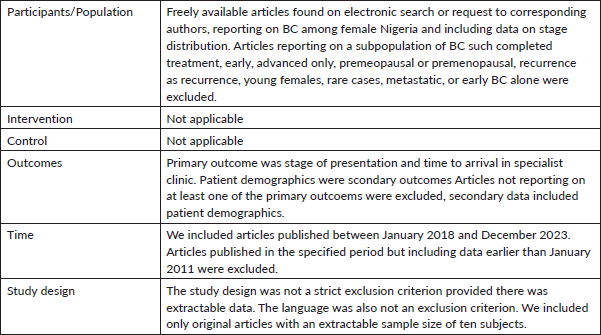
Quality assessment
We modified the CASP tool for quality assessment of the included articles. Five domains were considered as follows
- Validity/Relevance/applicability: assessed based on the aim
- Results presentation and reliability: assessed based on the presentation and absecne of descrepancy
- Bias: assessed based on the popoulation used; all or purposeive or subset
- Precision of staging : asseses based on the modality of staging and attempt to prevent recall bias
- Reporting: Assessed based on ease of extraction.

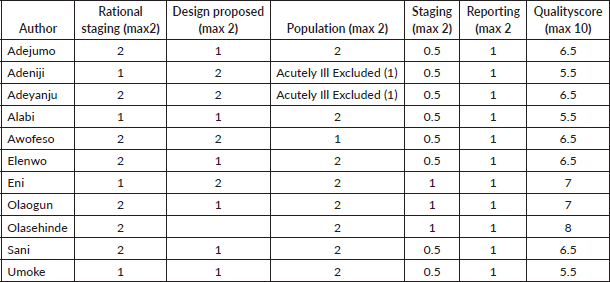
Forest plots
Marital status

Age distribution
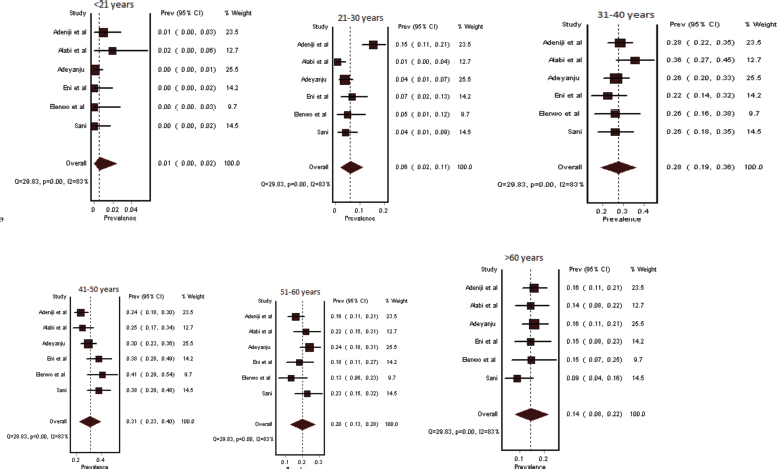
Duration before presentation at Tertiary Center

2018–2023 stage distribution (Four-stage categories)
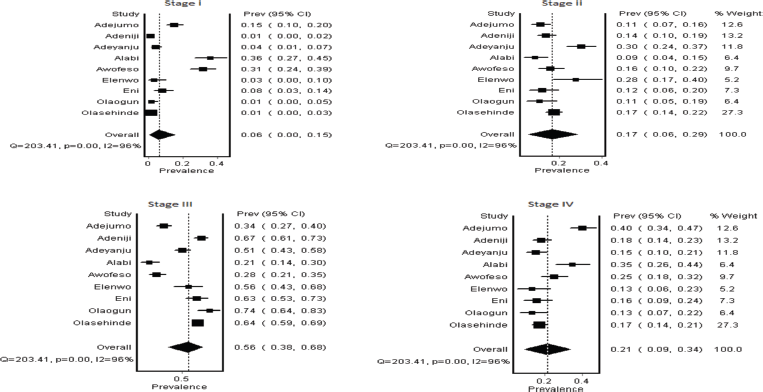
2018–2023 Two-stage distribution
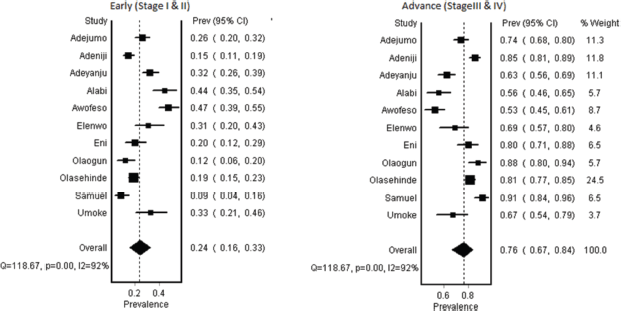
Sensitivity analysis
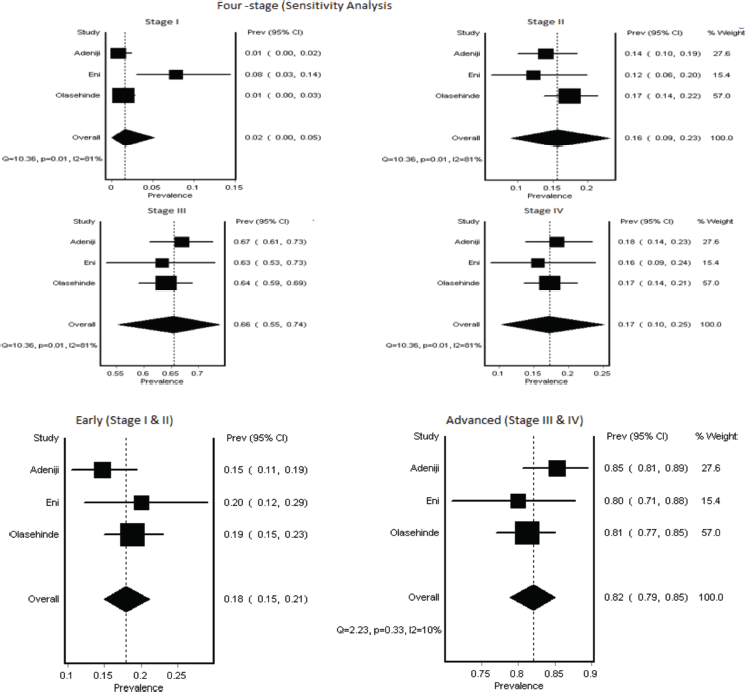
Historical data (reference) forest plot showing stage distribution of breast cancer in the period 2000–2018







